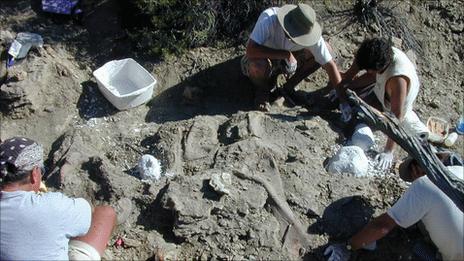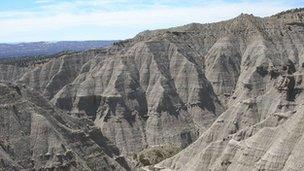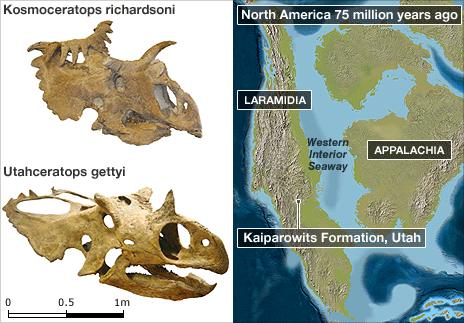Fossils of new species of horned dinos found in Utah
- Published

The Kosmoceratops had more horns on his head than any other dino
Scientists have unearthed two new species of giant plant-eating horned dinosaurs in southern Utah, US.
The creatures lived on the "lost continent" of Laramidia in the Late Cretaceous period, some 68 to 99 million years ago.
Laramidia was formed when a shallow sea flooded part of what is now North America and divided the continent in two.
The findings were published in the journal Plos One.
The scientists say the newly found dinos lived in the subtropical swampy environment.
They were close relatives of the dinosaur Triceratops, and belonged to the family known as ceratopsians. Ceratops means horned face in Greek.
'Giant rhino'
Although both species had a number of horns on their heads, the bigger one, dubbed Utahceratops gettyi, had a particularly large horn over the nose.
Mark Lowen, one of the authors of the study, said that the dinosaur resembled "a giant rhino with a ridiculously supersized head".
The second animal was named Kosmoceratops richardsoni and with a total of 15 horns on its head, it is the most ornate-headed dinosaur discovered to date.
Not only did it have a horn over its nose and a horn atop each eye, but also one at the tip of each cheek bone, and 10 across the rear margin of the bony frill.
"Kosmoceratops is one of the most amazing animals known, with a huge skull decorated with an assortment of bony bells and whistles," said Scott Sampson from the Utah Museum of Natural History, the study's lead author.
The scientist explained that despite a possibly horrendous appearance, it is doubtful that these dinosaurs used their horns in self-defence.
"Most of these bizarre features would have made lousy weapons to fend off predators," said Dr Sampson.

Palaeontologists call the Grand Staircase-Escalante National Monument a "largely unexplored dinosaur boneyard"
"It's far more likely that they were used to intimidate or do battle with rivals of the same sex, as well as to attract individuals of the opposite sex."
'Lost' land
The fossils were found in the desert landscape of Grand Staircase-Escalante National Monument (GSENM), in south-central Utah - a vast tract of land Dr Sampson called "one of the country's last great, largely unexplored dinosaur boneyards".

The dinos were found in the south-central Utah
When the Western Interior Seaway, a warm, shallow sea that existed in the Late Cretaceous, flooded what is now North America, the ancient continent got divided into Appalachia and Laramidia.
About the size of Australia, Laramidia was a rather small landmass, made up of what is now the US states of Montana, Wyoming, Utah, New Mexico, Alaska, western Texas, and the Canadian provinces of Alberta and Saskatchewan.
The dinosaurs that lived in Laramidia are among the best known to researchers because of the abundant fossil discoveries that have been made originating from this landmass.
Exciting finds
Over the past few months, palaeontologists have discovered a number of different species of horned dinosaurs.
"The new Utah creatures are the icing on the cake, showing anatomy even more bizarre than typically expected for a group of animals known for its weird skulls," said Andrew Farke of the Raymond Alf museum in Claremont, California, another of the paper's authors.

The newly found species lived on the ancient continent Laramidia
Dr Sampson agreed, adding that now was "an exciting time to be a palaeontologist".
"With many new dinosaurs still discovered each year, we can be quite certain that plenty of surprises still await us [in southern Utah]."
- Published26 May 2010